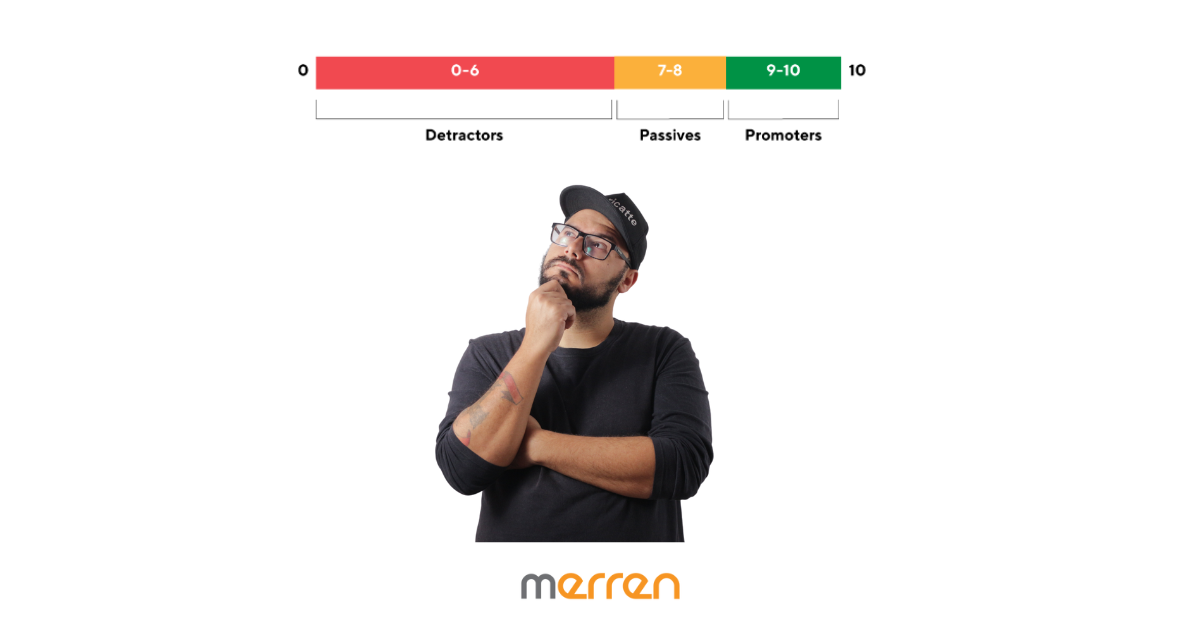Fred Reichheld is a business strategies and an American author who was working with Bain & Company in 2003. He came up with a metric to measure customer loyalty. He developed the net promoter system that underwent multiple development with time. It soon became a standardized method of tracking promoters and detractors to build a customer-centric relationship. Soon NPS scores defined the business growth and customer loyalty.
Net Promoter Score is a widely used and often touted as the gold standard metric for customer experience. NPS scores are measured with a single and a simple question:
“On a scale of 0-10, how willing are you to recommend <BRAND NAME> to your friends/ colleagues”
The net promoter score calculation is done as a difference between percent of promoters (those scoring 9 or 10) and detractors (those scoring 6 or lower) in the overall responses. The score can range from -100 to +100. A good net promoter score is the one with higher numbers.
What is the Net Promoter Score?
The Net Promoter Score (NPS) is a metric mainly deployed during a post purchase survey feedback. This scale is the world’s leading metric that is commonly used to measure customer loyalty and satisfaction. The score is measured over a 0-10 scale. It is calculated by subtracting the percentage of customers who responded with a score of 0 to 6 (detractors) from the percentage of customers who responded with a score of 9 to 10 (promoters). The resulting score ranges from -100 to +100.
A good NPS score indicates that more customers are promoters than detractors, while a negative score indicates that people might leave with a negative word of mouth. When the score falls to either 7 or 8, that could denote passives or people who are indifferent to your brand. The NPS scale is a valuable tool for businesses to measure customer satisfaction and identify areas where they can improve their products or services.
Unfortunately, as the adoption of Net Promoter Score has increased, so has its misuse. In this blog , we will explore the 5 reasons why companies can get their Net Promoter Score wrong:

1. Net promoter score is not a measure of customer loyalty
Net promoter score is a measure of how the buyer is readily willing to recommend the brand. That is not the same as loyalty. You can get loyal customers for your product, but they are not willing to recommend it to their friends, family or colleagues for several reasons. For example, they might think that while the product is great for them, it would not have similar value for their friends, family, or colleagues. Does that make them a disloyal consumer? This is especially important when products on intimate wellness or medical products are involved.
2. This metric does not determine customer retention
Lindy Law suggests that the longer a person has been with a company, they are expected to have an even longer customer journey with the brand. If NPS was indeed a measure of customer retention, it would mean that for such a consumer the NPS would remain the same or increase over time. However, for stable products, NPS is naturally downward trending. What was a delight in the beginning, would become a hygiene expectation for customer service over time.
3. NPS is not a competitive benchmarking tool
Unless you benchmark with extreme precision. Companies often benchmark this metric against their category competitors to evaluate the performance of their customer facing teams. However, the NPS gets impacted by several variables other than the category. It can be noted that the time spent with a company would impact the score. Hence, an older company with a larger mix of old patrons would have lower NPS than a young startup with a brand new customer base.
4. NPS gets colored by marketing buzz
Companies often see an uptick in the NPS results coinciding with their successful marketing campaigns. This can occur even though nothing inherent has changed with the product or with the customer satisfaction segment. Good marketing campaigns make a brand look like a winner and people want to pick a winning side. However, attributing the spurt in NPS scale due to the success of marketing to improved customer success can be misleading.
5. Responses on sensitive categories will not give accurate data
Some categories are not “recommendation” friendly in the NPS survey. So the customer feedback on these items will not give accurate data. Especially, in sensitive categories like sexual wellness or contraceptives, pharmaceutical products, intimate wellness . The idea of recommendation in these categories might be a barrier irrespective of a good customer experience.
The Best Practices of Customer Feedback Using NPS System
The main purpose of the net promoter scale is that it measures customer experience and predicts business growth. The average NPS score denotes how likely your customers are to recommend your business. Using these NPS results, one can capture happy customers and identify unhappy customers.
Detect churn with real-time feedback
The best way to get fresh and authentic responses is usually during a post-purchase transaction. This method can yield a high response rate and you can get more nps feedback by soliciting real time responses. Every feedback gets collected over the Merren dashboard. The nps data can be segregated into the number of promoters and overall nps results.

Use survey distribution channels (email and messenger)
Launch survey via different platforms of email, Whatsapp surveys, social media platforms, interactive AMP emails where users can answer surveys from within the application. One way to capture candid data is to use platforms used by your consumer base. This can immediately help identify passive customers which is an opportunity for businesses to convert them to promoters.
Simplicity is the key
Keep the survey questions very simple and easy for users to comprehend. You can also use the 3-point scale and 5-point scale in the surveys. It is important to capture these metrics of customer satisfaction using industry based benchmarks. However, just deploying surveys is never enough. The customer support can focus on a follow-up question after resolving issues and conflicts. This way, they can ensure a better CX.
Using Merren, you can effectively manage customer feedback with our robust tools. Sign up for a 14 day free trial and supercharge the way you collect feedback. Create a customer journey mapping tool and change the way you collect real time feedback.





